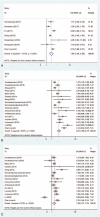Association between serum uric acid levels and dyslipidemia in Chinese adults: A cross-sectional study and further meta-analysis
- PMID: 32176036
- PMCID: PMC7440131
- DOI: 10.1097/MD.0000000000019088
Association between serum uric acid levels and dyslipidemia in Chinese adults: A cross-sectional study and further meta-analysis
Abstract
This study aimed to investigate the association of serum uric acid (SUA) levels with dyslipidemia and its components and to further explore the age- and gender-specific association of SUA levels with dyslipidemia in Chinese adults.A cross-sectional study was performed among 8642 adults who underwent health examinations. A meta-analysis covering 17 studies was conducted to confirm the results.The prevalence of hyperuricemia and dyslipidemia was 9.25% and 20.44%, respectively. Participants with hyperuricemia had higher prevalence of dyslipidemia than those without hyperuricemia (34.42% vs 19.01%, P < .005). Compared with participants with SUA in the first quintile, the odds ratio (OR) (95% confidence interval) of dyslipidemia in the second, third, fourth, and fifth quintiles of SUA were 1.095 (0.901-1.332), 1.582 (1.315-1.904), 2.095 (1.752-2.505), and 3.212 (2.702-3.818), respectively. Subgroup analysis showed that SUA quintiles were significantly correlated with the likelihood of dyslipidemia in females aged > 50 years and in males, but not in females aged ≤50 years. The meta-analysis also showed that hyperuricemia increased the likelihood of dyslipidemia and the pooled OR for the highest uric acid level vs the lowest uric acid level was 1.84 (1.49-2.28).SUA levels are significantly associated with dyslipidemia, and this association is impacted by age and gender.
Conflict of interest statement
The authors have no conflicts of interest to disclose.
Figures


Similar articles
-
Investigating the Relationship Between Serum Uric Acid and Dyslipidemia in Young Adults in Bangladesh.Endocrinol Diabetes Metab. 2025 May;8(3):e70063. doi: 10.1002/edm2.70063. Endocrinol Diabetes Metab. 2025. PMID: 40420797 Free PMC article.
-
The relationship between serum uric acid and lipid profile in Bangladeshi adults.BMC Cardiovasc Disord. 2019 Feb 21;19(1):42. doi: 10.1186/s12872-019-1026-2. BMC Cardiovasc Disord. 2019. PMID: 30791868 Free PMC article.
-
The association between serum uric acid levels, metabolic syndrome and cardiovascular disease in middle aged and elderly Chinese: results from the DYSlipidemia International Study.BMC Cardiovasc Disord. 2015 Jul 11;15:66. doi: 10.1186/s12872-015-0059-4. BMC Cardiovasc Disord. 2015. PMID: 26160354 Free PMC article.
-
Geographical distribution of hyperuricemia in mainland China: a comprehensive systematic review and meta-analysis.Glob Health Res Policy. 2020 Nov 30;5(1):52. doi: 10.1186/s41256-020-00178-9. Glob Health Res Policy. 2020. PMID: 33292806 Free PMC article.
-
Updated Evidence of the Association Between Elevated Serum Uric Acid Level and Psoriasis.Front Med (Lausanne). 2021 Jun 29;8:645550. doi: 10.3389/fmed.2021.645550. eCollection 2021. Front Med (Lausanne). 2021. PMID: 34268318 Free PMC article.
Cited by
-
A machine learning approach to personalized predictors of dyslipidemia: a cohort study.Front Public Health. 2023 Sep 20;11:1213926. doi: 10.3389/fpubh.2023.1213926. eCollection 2023. Front Public Health. 2023. PMID: 37799151 Free PMC article.
-
Dyslipidemia and its associated factors among adult cardiac patients at Ambo university referral hospital, Oromia region, west Ethiopia.BMC Cardiovasc Disord. 2023 Jun 24;23(1):321. doi: 10.1186/s12872-023-03348-y. BMC Cardiovasc Disord. 2023. PMID: 37355585 Free PMC article.
-
Establishing a predictive model for liver fluke infection on the basis of early changes in laboratory indicators: a retrospective study.Parasit Vectors. 2025 May 22;18(1):186. doi: 10.1186/s13071-025-06833-9. Parasit Vectors. 2025. PMID: 40405253 Free PMC article.
-
Gender-specific assessment of lipid profiles correlation with serum uric acid in non-dialysis chronic kidney disease patients: Prospective observational cross-sectional study.Front Endocrinol (Lausanne). 2025 Jul 30;16:1641978. doi: 10.3389/fendo.2025.1641978. eCollection 2025. Front Endocrinol (Lausanne). 2025. PMID: 40810061 Free PMC article.
-
Associations of serum uric acid with cardiovascular disease risk factors: a retrospective cohort study in southeastern China.BMJ Open. 2023 Sep 27;13(9):e073930. doi: 10.1136/bmjopen-2023-073930. BMJ Open. 2023. PMID: 37758669 Free PMC article.
References
-
- Liang Z, Qiu QY, Wu JH, et al. Alcohol drinking, dyslipidemia, and diabetes: a population-based prospective cohort study among inner mongolians in China. Biomed Environ Sci 2016;29:555–62. - PubMed
-
- Katsiki N, Mikhailidis DP, Mantzoros CS. Non-alcoholic fatty liver disease and dyslipidemia: an update. Metabolism 2016;65:1109–23. - PubMed
-
- Zhang M, Deng Q, Wang L, et al. Prevalence of dyslipidemia and achievement of low-density lipoprotein cholesterol targets in Chinese adults: a nationally representative survey of 163,641 adults. Int J Cardiol 2018;260(undefined):196–203. - PubMed
Publication types
MeSH terms
Substances
LinkOut - more resources
Full Text Sources

